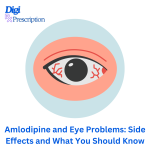
Amlodipine is a commonly prescribed medication for high blood pressure (hypertension) and certain heart conditions. While it effectively helps control blood pressure, some people may experience eye-related side effects. This article explores the potential eye problems linked to amlodipine, how to recognize symptoms, and when to seek medical help.
Can Amlodipine Cause Eye Problems?
Although eye problems are not common with amlodipine, some users have reported side effects affecting their vision. Here are some potential ocular (eye-related) issues associated with this medication:
1. Blurred Vision
-
Amlodipine may cause temporary blurred vision due to changes in blood pressure or fluid retention.
-
If blurriness persists, it could indicate an adverse reaction.
2. Dry Eyes
-
Some users experience reduced tear production, leading to irritation and discomfort.
-
Symptoms include redness, a gritty sensation, and sensitivity to light.
3. Swelling Around the Eyes (Periorbital Edema)
-
Amlodipine can cause fluid retention, leading to puffiness around the eyes.
-
This swelling may appear under the eyes or on the eyelids.
4. Conjunctivitis (Eye Irritation and Redness)
-
Some people may develop eye inflammation, causing redness and discomfort.
-
This condition, often called "pink eye," can be accompanied by excessive tearing.
5. Increased Eye Pressure (Rare)
-
Although rare, amlodipine may contribute to increased intraocular pressure (IOP), which can be a concern for glaucoma patients.
-
Those with pre-existing eye conditions should monitor their eye health closely.
When to Seek Medical Help
⚠️ Contact your doctor if you experience:
✅ Persistent blurred vision or difficulty focusing
✅ Severe eye redness, pain, or swelling
✅ Sudden changes in vision clarity or light sensitivity
✅ Increased pressure or discomfort in the eyes
If you already have glaucoma or other eye conditions, discuss amlodipine alternatives with your doctor.
How to Manage Eye Problems from Amlodipine
???? Use Artificial Tears – Helps relieve dry eyes and irritation.
???? Monitor for Swelling – If eye puffiness worsens, consult a doctor.
???? Stay Hydrated – Reduces fluid retention and improves eye health.
???? Regular Eye Checkups – Essential if you have pre-existing eye conditions like glaucoma or cataracts.
Conclusion
While amlodipine is generally safe, some people may experience eye-related side effects, such as blurred vision, dry eyes, or swelling. Monitoring symptoms and consulting an ophthalmologist if issues persist can help prevent complications. If eye problems significantly impact your daily life, your doctor may suggest an alternative blood pressure medication.
References:
-
U.S. National Library of Medicine – Amlodipine Side Effects – https://www.ncbi.nlm.nih.gov
-
Mayo Clinic – Amlodipine and Hypertension Management – https://www.mayoclinic.org
-
American Academy of Ophthalmology – Medication-Induced Eye Problems – https://www.aao.org
